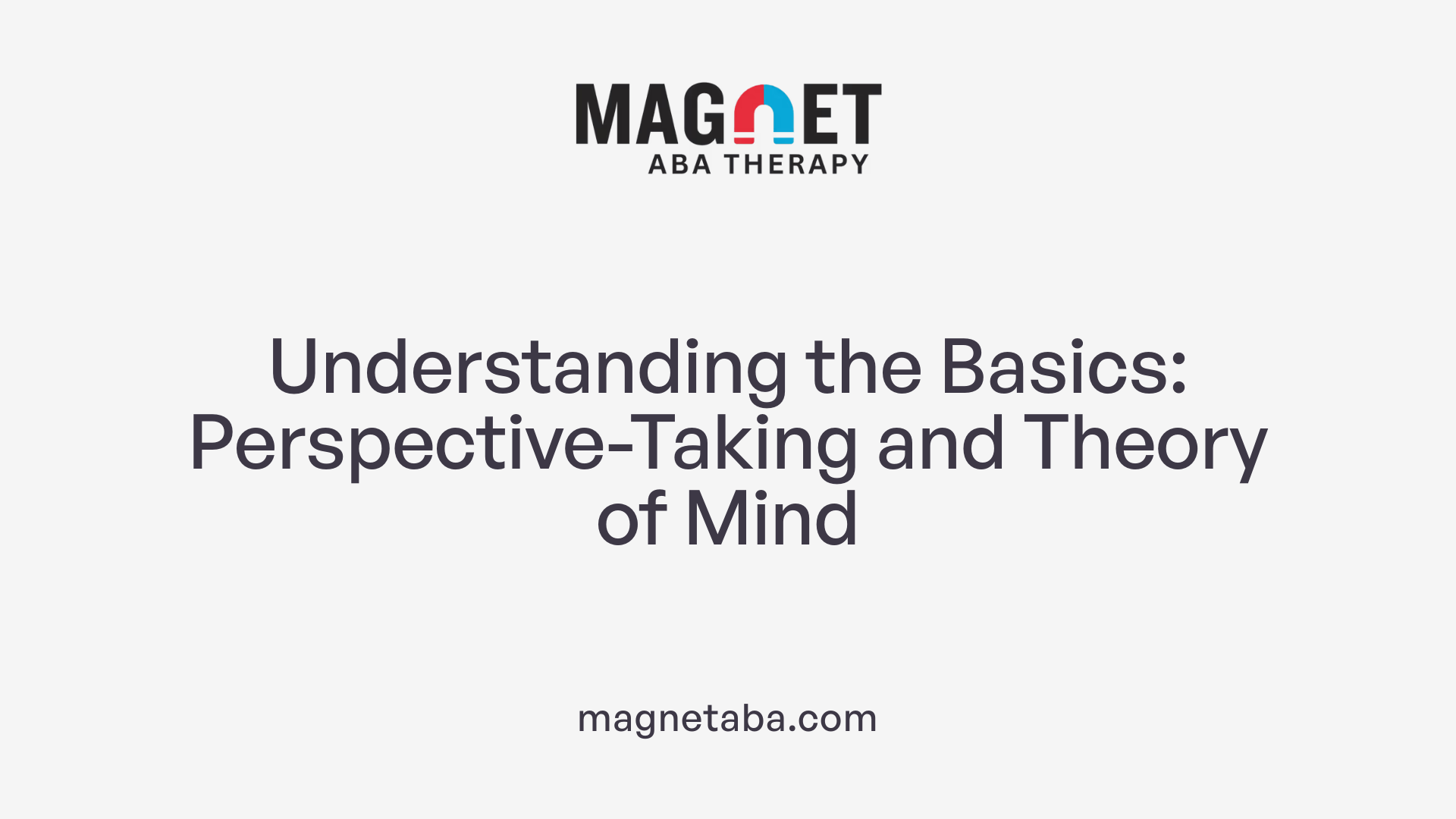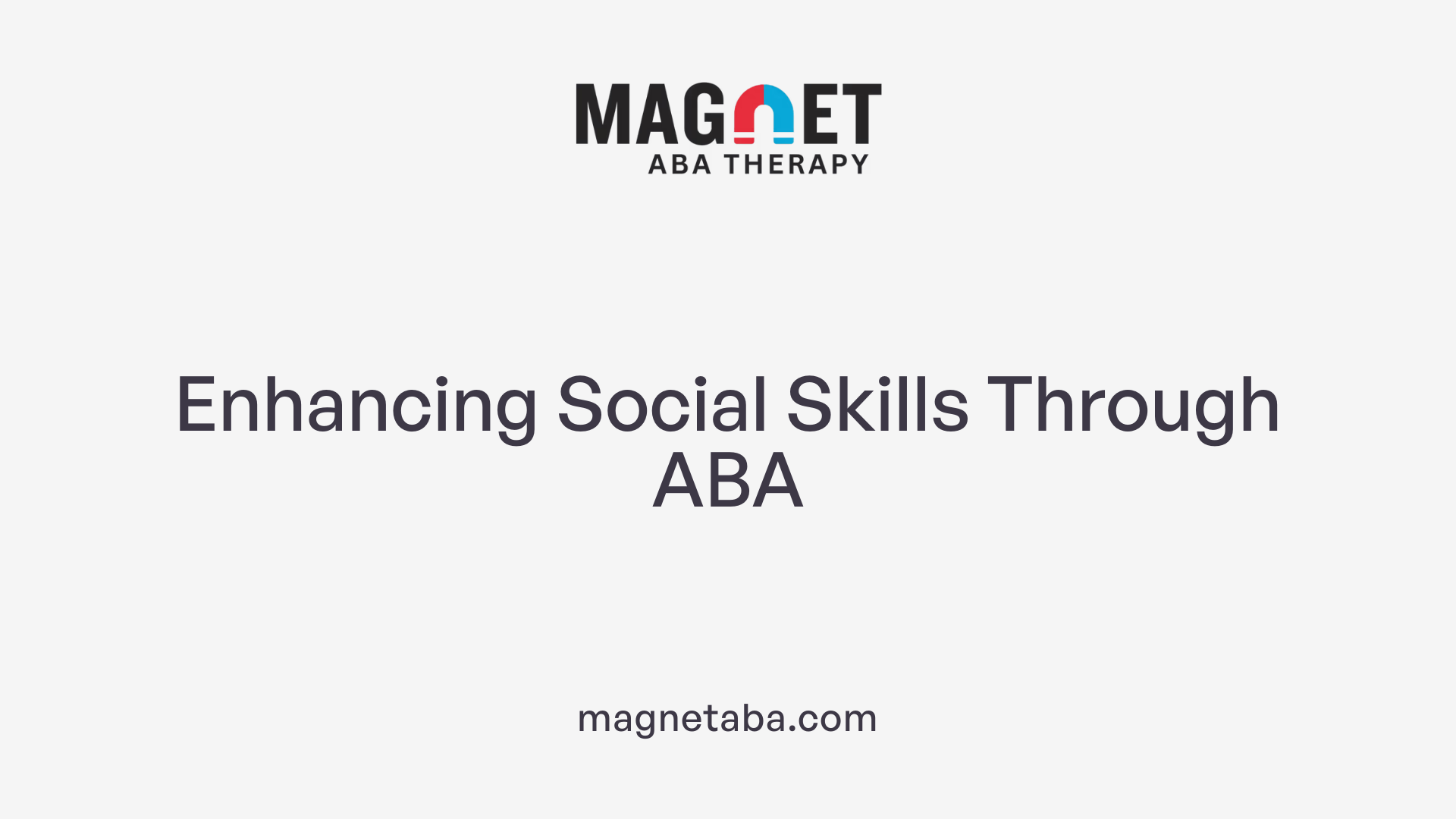Unlocking the Power of Perspective in Autism Support
Understanding and improving perspective-taking skills in individuals with autism spectrum disorder (ASD) is crucial for enhancing social interactions and emotional understanding. Applied Behavior Analysis (ABA) therapy has emerged as a systematic, evidence-based approach that directly targets these skills, fostering genuine social engagement and respecting neurodiversity. This article explores how ABA can effectively develop perspective-taking, the research backing its methods, and the importance of ethical, respectful practice frameworks.
The Foundations of Perspective-Taking and Theory of Mind

What are perspective-taking and Theory of Mind (ToM)?
Perspective-taking is the ability to see the world from someone else's viewpoint and adjust one's behavior accordingly. It involves understanding others' thoughts, feelings, desires, and needs. Theory of Mind (ToM), on the other hand, refers to the capacity to recognize that others have distinct mental states—such as beliefs, intentions, and emotions—that can differ from one's own.
For example, understanding that different people have different food preferences demonstrates ToM, as it shows awareness of others’ tastes and perspectives.
How does autism spectrum disorder (ASD) impact these skills?
Children with ASD often face challenges in developing ToM, which affects their ability to grasp nuanced social cues, recognize emotions, understand jokes, or detect deception. This difficulty hampers effective social interactions and emotional understanding.
Research indicates that typically developing children begin developing ToM around age 4; however, children with ASD may lag behind, making social engagement more difficult.
Why is mastering perspective-taking and ToM important?
These skills are crucial for successful social interactions, enabling individuals to interpret others' behaviors accurately, predict reactions, and respond appropriately. They help build empathy and foster meaningful relationships.
Teaching these skills directly, especially through targeted interventions, can lead to improvements in social competence. Techniques such as direct instruction, role-playing, and visual aids like facial expression sorting help children with autism better understand and navigate social worlds.
Innovative strategies in practice
Applied Behavior Analysis (ABA) employs multiple strategies to enhance perspective-taking and ToM, including:
- Role-playing to practice real-life social scenarios
- Video modeling to demonstrate social cues
- Social narratives to explain perspectives
- Naturalistic teaching setups to promote generalization of skills
Research by Welsh et al. (2019) demonstrated that teaching children with ASD to tact others' mental states across all five senses in a natural environment resulted in successful skill acquisition.
Focus beyond traditional social skills drills
While traditional interventions focus on teaching neurotypical social behaviors like eye contact, recent evidence suggests these do not significantly increase peer likability or reduce masking behaviors. Instead, practices emphasizing acceptance and understanding of social presentation differences are more effective.
Therapies centered on perspective-taking aim to empower autistic individuals to interpret and predict others' mental states rather than forcing conformity to societal norms. This approach aligns with neurodiversity principles and promotes authentic self-expression.
| Strategy | Description | Goal |
|---|---|---|
| Direct Teaching | Explicit instruction in recognizing emotions and mental states | Improve social understanding and responses |
| Video Modeling | Watching videos of social interactions to learn cues | Enhance observational skills |
| Social Narratives | Stories explaining social concepts and perspectives | Foster contextual understanding |
| Naturalistic Teaching | Incorporating skills into everyday situations | Generalize skills to real life |
Ultimately, focusing on perspective-taking supports autistic individuals in developing empathy, improving social interactions, and advocating for themselves, fostering respect and acceptance in diverse social settings.
Research Evidence Supporting ABA's Effectiveness

What evidence supports the effectiveness of ABA therapy in improving perspective-taking?
Research indicates that Applied Behavior Analysis (ABA) can effectively promote perspective-taking skills in children with autism. One prominent approach involves targeted teaching strategies such as video modeling and naturalistic teaching. These methods leverage visual and real-life contexts to facilitate skill acquisition.
For example, a study by Gould et al. (2011) showed that using video modeling to teach children to tact others' mental states across different senses led to measurable improvements in perspective-taking. These improvements were observed through structured assessments and real-world social interactions.
Moreover, research by Welsh et al. (2019) demonstrated that teaching children to identify what others see, think, and feel—core components of Theory of Mind—can lead to better social understanding. Stauch et al. (2018) emphasized the value of naturalistic teaching environments where children practice social perception skills in more authentic settings.
However, these studies also highlight limitations, particularly regarding the generalization of skills beyond trained contexts. Often, children may excel in specific tasks but struggle to apply their skills flexibly in new social situations.
In summary, evidence supports that ABA, especially when incorporating visual aids like video modeling and naturalistic teaching strategies, can improve perspective-taking. Still, current research stresses the importance of techniques that enhance generalization to ensure lasting, meaningful social benefits for individuals with autism.
Impact of ABA on Broad Social Skills Development

How does ABA intervention influence social skill growth, including perspective taking?
Applied Behavior Analysis (ABA) has proven highly effective in supporting the development of broad social skills for children with autism spectrum disorder (ASD). This approach systematically breaks down social behaviors such as reciprocal communication, turn-taking, and emotional understanding into smaller, teachable steps.
Through structured activities and reinforcement, children learn to interpret social cues like body language, facial expressions, and tone of voice. Techniques such as role-playing, modeling, and error correction create engaging learning environments that motivate children to practice and internalize social responses.
Activities are often carried out in naturalistic and group settings, which are critical for fostering real-world social interactions. These settings allow children to apply learned skills in more unpredictable conditions, enhancing their ability to generalize behavior outside of therapy.
Research shows that ABA interventions can significantly improve social engagement, helping children develop emotional awareness and responsive communication. These skills not only improve immediate social interactions but also support long-term social inclusion and confidence.
How does teaching and reinforcing social cues and behaviors contribute?
Teaching specific social cues such as making eye contact, recognizing facial expressions, and understanding social rules are central to ABA programs. Each cue is carefully broken down into manageable steps, and children are reinforced for correct responses.
Reinforcers like praise or tangible rewards motivate children to participate actively. Natural reinforcement, where the child sees the real-world benefits of their social behaviors, encourages ongoing practice.
Positive reinforcement and systematic targeting ensure that children become more responsive to social cues, which are fundamental for effective social interactions and emotional understanding.
What role do naturalistic and group settings play in fostering social skills?
Naturalistic teaching environments mimic everyday situations, making learning relevant and easier to generalize. Group settings allow children to practice social skills with peers, promoting social reciprocity and spontaneous interaction.
Group therapy sessions, playdates, and community outings are typical naturalistic contexts where children can apply social skills learned during structured sessions.
These settings also help children develop confidence and reduce social anxiety, as they engage in real-life interactions and receive immediate feedback.
| Aspect | Effect | Techniques Used | Additional Details |
|---|---|---|---|
| Social reciprocity | Improves give-and-take in conversations | Role-playing, peer modeling | Enhances mutual understanding and cooperation |
| Recognizing social cues | Better interpretation of facial expressions and body language | Visual aids, social stories | Fundamental for emotional intelligence |
| Communication skills | Reciprocal and functional communication | Shaping, chaining, reinforcement | Key for meaningful social engagement |
| Generalization of skills | Applying skills in real-world settings | Naturalistic teaching, community outings | Essential for lasting social competence |
ABA therapy, through its structured and evidence-based methods, facilitates comprehensive development in social skills, equipping children with ASD to navigate social environments more effectively and confidently.
Strategies and Techniques in ABA for Perspective-Taking
What strategies are used in ABA therapy to develop perspective-taking abilities?
Applied Behavior Analysis (ABA) employs a variety of methods to foster the development of perspective-taking skills in individuals with autism spectrum disorder (ASD). These strategies are backed by research evidence and tailored to enhance social cognition.
One primary approach involves direct instruction using social narratives. These stories outline social situations and explicitly teach how to interpret others' thoughts and feelings. Accompanying this, video modeling provides visual demonstrations of perspective-taking in real-life social contexts, allowing learners to observe and imitate appropriate responses.
Naturalistic teaching methods also play a crucial role. These techniques embed learning opportunities into everyday situations, enabling learners to practice and generalize skills outside structured sessions. For example, clinicians might create scenarios where children interpret facial expressions or respond to peers' emotions during play.
To teach specific social cognition skills, ABA therapists utilize multiple exemplar training, which involves exposing learners to various examples of social situations, preventing rote memorization and promoting flexible understanding. Reinforcement methods, such as praise or tokens, are used consistently to strengthen successful perspective-taking responses.
In addition, prompting and error correction guide learners toward correct responses, gradually fading prompts as competence increases. Behavioral skills training with rules helps teach complex skills like understanding false beliefs, false belief tests, and recognizing deception.
Together, these strategies combine systematic teaching, visual supports, and reinforcement to improve social understanding. The ultimate goal is to help individuals with ASD interpret others' mental states accurately, leading to improved social interactions and emotional awareness.
Teachings on Recognizing Facial Expressions and Social Cues
How does ABA therapy help children recognize and interpret facial expressions and social cues?
Applied Behavior Analysis (ABA) therapy plays a crucial role in helping children with autism recognize and interpret facial expressions and social cues. This is achieved through structured, systematic teaching techniques that break down complex social awareness skills into manageable steps.
Therapists often use visual prompts and activities that focus on emotional content, such as reading books with expressive characters or demonstrating facial cues in real-time. These activities help children learn to identify emotions like happiness, sadness, and surprise.
In addition, methods like video modeling expose children to numerous examples of facial expressions in different situations, reinforcing their learning. One innovative approach involves tools like the 'Superpower Glass' system, which employs facial recognition technology to provide real-time visual and auditory cues during social interactions. This system helps children interpret others’ emotions more effectively as they navigate real-world settings.
Consistent practice with these techniques is essential. Repeated exposure and reinforcement help solidify understanding, leading to improvements in emotion recognition, eye contact, and general social engagement. Over time, these approaches foster better understanding and more appropriate responses to social cues, enhancing communication opportunities for children with autism.
Supporting Perspective-Taking Through Parental and Professional Roles

How can parents and professionals support perspective-taking through ABA?
Supporting perspective-taking in individuals with autism involves targeted strategies within Applied Behavior Analysis (ABA). Parents and practitioners can utilize a variety of techniques to teach understanding of others’ thoughts, feelings, and viewpoints.
One effective approach is the use of social stories and video modeling. These tools visually depict social situations and highlight different perspectives, helping individuals grasp how others perceive and react to various scenarios.
Role-play activities are also beneficial. By acting out social interactions, individuals can practice recognizing emotions, motives, and beliefs, gaining confidence in navigating real-world social contexts.
Naturalistic teaching methods—such as embedding learning opportunities within everyday routines—create authentic contexts for practicing perspective-taking. This approach allows learners to observe and respond to social cues in familiar environments.
Reinforcement plays a critical role. Positive feedback for demonstrating understanding promotes motivation while emphasizing authentic communication over rote responses. Importantly, teaching should focus on social perceptions and motivations, fostering genuine empathy rather than encouraging masking behaviors.
Beyond behavioral techniques, fostering self-awareness and empathy is essential. Helping individuals recognize their own emotions and how they influence behavior supports the development of perspective-taking skills.
In summary, parents and professionals can support this skill through systematic, visual, and natural methods that promote understanding and authentic social interaction. These strategies empower individuals with autism to engage more meaningfully with others and enhance their social experiences.
Ethical and Inclusive Approaches in ABA
 When applying ABA therapy to improve perspective-taking in autistic individuals, ethical considerations are of utmost importance. Practitioners should always respect each person's dignity and autonomy, ensuring that interventions do not force individuals to mask their true selves or conform strictly to neurotypical social norms.
When applying ABA therapy to improve perspective-taking in autistic individuals, ethical considerations are of utmost importance. Practitioners should always respect each person's dignity and autonomy, ensuring that interventions do not force individuals to mask their true selves or conform strictly to neurotypical social norms.
A neurodiversity-affirming approach emphasizes understanding and accepting social presentation differences. Instead of solely aiming to modify internal mental states or behaviors, therapy should empower autistic individuals to communicate their perceptions and feelings authentically.
This involves obtaining informed consent and maintaining transparency throughout the intervention process. Respecting personal boundaries and fostering trust are essential components of ethical practice.
Therapists must be cautious of methods that could cause harm or infringe on personal rights. Any intervention should focus on supporting self-advocacy and promoting skills that enhance social engagement without pressuring individuals to hide their identity or adopt superficial behaviors.
In summary, ethical ABA for perspective-taking prioritizes respect, acceptance, and empowerment. It aligns with principles of beneficence, justice, and promoting the well-being of autistic individuals, ensuring that therapy is both effective and respectful.
Applying ABA Within Neurodiversity-Affirming Frameworks
Supporting strengths and individual preferences
When integrating ABA techniques into neurodiversity-affirming approaches, the focus shifts from merely teaching socially normative behaviors to recognizing and supporting each individual’s unique strengths. Instead of imposing standard social scripts, practitioners collaborate with autistic individuals to identify areas where they excel and feel comfortable. This strength-based approach encourages self-expression and builds confidence.
In practice, personalized goals are set based on what the individual values, which might include authentic ways of communicating or substantial interests. Visual aids, social narratives, and role-playing can be tailored to align with these preferences. For example, teaching perspective-taking skills can involve activities that respect the individual's learning style while promoting understanding of others' emotions and motives.
Promoting genuine social connections
Genuine social relationships are built on mutual understanding and acceptance. ABA strategies can support this by teaching skills like active listening, emotional recognition, and respectful communication, but without pressuring conformity to neurotypical norms. Techniques such as naturalistic teaching—arranged around real-life contexts—can foster more authentic interactions.
For instance, using peer-mediated interventions or natural settings gives autistic individuals the opportunity to practice social skills in meaningful environments. Emphasizing shared interests and authentic responses rather than rote behaviors helps individuals form connections rooted in mutual respect.
Respecting neurodiversity and reducing masking
A core principle of neurodiversity is celebrating neurological differences rather than attempting to correct or normalize them. ABA's traditional focus on modifying behaviors often inadvertently encourages masking—where autistic people hide parts of their true selves to fit societal expectations.
A neurodiversity-affirming application of ABA involves teaching skills that support self-advocacy and emotional understanding without imposing neurotypical standards. This includes teaching individuals to recognize their own needs, communicate authentically, and navigate social situations on their terms.
Efforts should be made to create a supportive environment that reduces the pressure to mask, which can be harmful in the long term. Respecting each person's unique way of socializing and valuing their identity fosters healthier, more fulfilling relationships.
| Strategy | Approach | Goal | Incorporates Neurodiversity Principles |
|---|---|---|---|
| Strengths-based teaching | Identifying individual talents and interests | Build confidence and engagement | Recognizes individual desirability |
| Naturalistic teaching | Using real-life contexts for practice | Promote authentic interactions | Supports genuine communication |
| Bi-directional communication | Emphasizing mutual understanding | Foster trust and respect | Respects personal identity and preferences |
| Self-advocacy training | Teaching to express needs and boundaries | Empower autonomy | Upholds self-determination |
By adopting these approaches, ABA can be aligned with principles of neurodiversity—prioritizing dignity, respecting differences, and supporting meaningful social participation.
Supporting Social Growth Respectfully
In conclusion, ABA therapy, when implemented thoughtfully and ethically, plays a vital role in enhancing perspective-taking skills, thereby improving social understanding for individuals with autism. Emphasizing methods that promote authenticity, self-awareness, and acceptance aligns with contemporary neurodiversity principles. Integrating research-backed strategies such as video modeling, social narratives, and naturalistic teaching, combined with ethical practice, ensures that therapy supports meaningful social connections and respects individual differences. As understanding and approaches evolve, the focus remains on empowering autistic individuals to develop social cognition within frameworks that honor their dignity and personal goals, fostering genuine and respectful social growth.
References
- How Teaching Perspective Taking to Individuals with Autism ...
- Theory of Mind and Perspective Taking - How to ABA
- Why Perspective-Taking and Neurodiversity Acceptance? (Part 2 of ...
- Developments in ABA: Teaching Perspective-Taking to Children ...
- Easy Ways to Teach Perspective Taking to an Autistic Child
- How ABA Therapy Helps With Social Skills
- How Teaching Perspective Taking to Individuals with Autism ...
- Episode 127 - Perspective Taking - ABA Inside Track












